Table of Contents
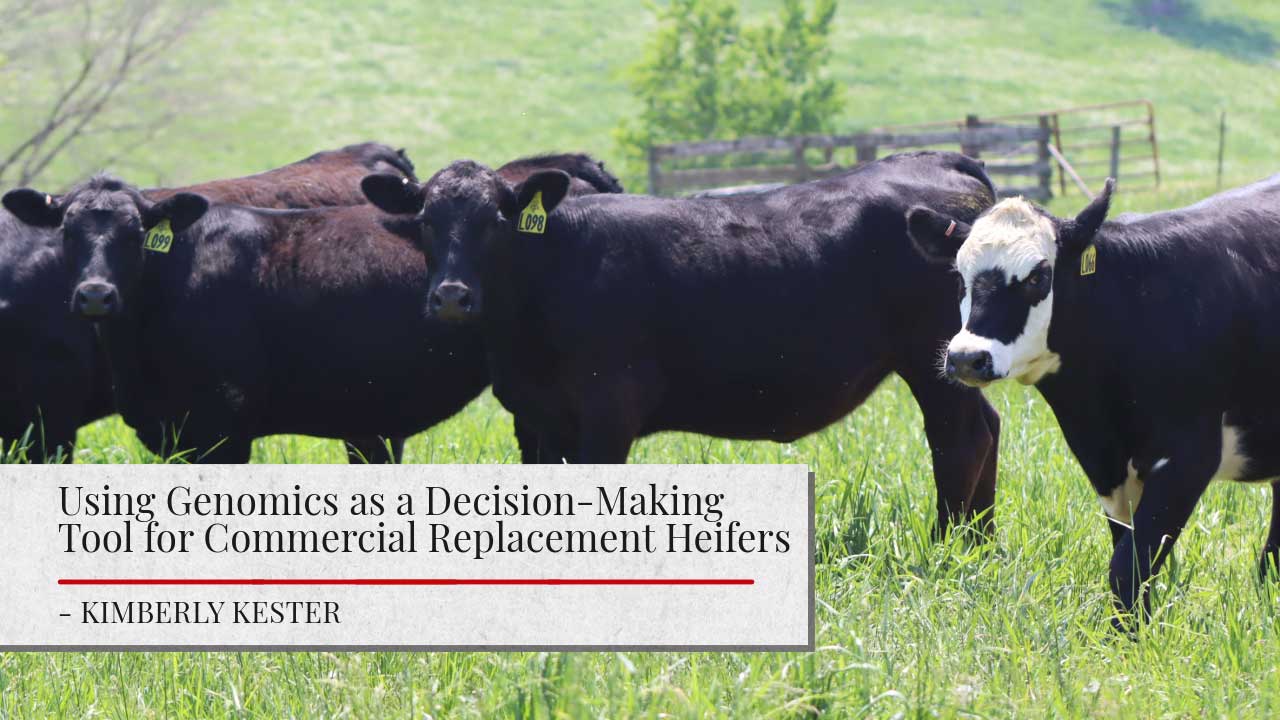
Genomic testing can save beef producers time and money when deciding which heifers to retain within their herd. A comparison of two commercial heifers explains how to interpret genomic reports.
Introduction
Which of these commercial heifers would you keep
for breeding?
Animal selection criteria such as conformation, docility, and body size can be accurately judged by visually evaluating an animal. These visual characteristics are known as an animal’s
phenotype. Registered animals have expected progeny differences (EPDs) or EPDs from the sire and dam to help make decisions about retention within the herd.
However, commercial animals may not have pedigree data available, and their selection must be made by other means. Visual evaluation is an excellent starting point, and incorporating the use of genomic reports can further improve selection decisions in your herd.
Basics of Genomic Evaluation
Genomics utilizes an animal’s complete DNA, or genome, to predict future performance. It’s similar to reading the blueprint for each individual animal. Thousands of genetic markers called SNPs (single nucleotide polymorphisms), or “snips”, are responsible for the genetic variation within an individual. SNPs allow the animal’s genome to be read and interpreted into molecular breeding values (MBVs).
MBVs are the genetic version of estimated breeding values (EBVs), which are calculated using performance data from the individual, sire and dam, and any progeny. EBVs indicate the
performance of the individual and are halved to predict performance of progeny, resulting in EPDs. Sire summaries typically show EPDs for traits.
Traits Included
Genomic reports can include a variety of traits used for different selection purposes. Genetics companies offer beef animal genomic testing for maternal, performance, and terminal traits, as well as indexes that combine multiple traits from
different categories. A limited number of companies offer a hybrid vigor (heterosis) test. Hybrid vigor is not heritable and is used to assess increased vigor of an individual due to
crossbreeding. An example genomic report is shown in Figure 1 and Figure 2.
When to Use
Numerous tools are available to inform cattle producers’ breeding decisions, whether it be on the bull or heifer and cow side of the equation. Animal data from genomics should be used to improve confidence in decisions, not to replace the use of phenotypic characteristics or performance data with EPDs. Phenotypic data is still necessary to create data pools for EPDs and genomics.
Hair or blood samples can be taken from calves at weaning or from bred heifers to make replacement decisions. Having genomic reports available can also add value for marketing purposes if selling as replacements.
Benefits
Since samples can be pulled from calves, genomics can help accelerate genetic improvement in the herd by allowing decisions to be made at a younger age. It also provides deeper insight than “eyeballing” crossbred animals who may not have extensive data from pedigrees.
Take advantage of hybrid vigor that cannot be determined through performance data. Hybrid vigor has a strong influence on traits with low heritability, such as maternal and fertility traits.
Better hybrid vigor typically translates to better fertility, feed efficiency, and stayability in the herd. Identify your best and worst future performers. If you have a large group of replacement heifers and need to make cuts, genomics easily identifies the animals with the least potential in a group.
Genomic reports include easy to understand indexes and scores for quick decisions, and more in-depth genetic effect and detailed reports are also available for making specific adjustments within your herd.
Save on rearing costs by culling sooner. On average it costs about $2,000 per head to raise a replacement heifer. Early screening can prevent spending money on heifers with poor potential. The cost of genomic testing is roughly $40 per animal, depending on which base test and add-on tests you select.
Decision-Making Example
Eleven commercial replacement heifers were selected from the University of Wisconsin beef herd at Lancaster Agricultural Research Station (LARS) to demonstrate how genetic merit can be used as a selection tool.
Igenity® Beef and Igenity® Envigor™ reports were generated on all heifers. The heifers were ranked by their Total Cow Index score, which most closely aligned with the LARS herd goals. All replacement heifers’ genomic results are included (Figures 1 & 2) to show how decisions might be made within the group. Scores are on a 1 to 10 scale, with higher scores typically being more favorable. Also included is a more in-depth comparison of the top and bottom heifers’ genomic reports side-by-side (Table 1) with descriptions of how their scores differ and how it informs selection decisions.
Heifer #L026, Total Cow Index of 6.62.

Heifer #L066, Total Cow Index of 4.13.

Figure 1. Example genomic report for a group of commercial beef heifers.
References
Neogen. (2023). Igenity beef handbook. Neogen Genomics.
https://www.neogen.com/globalassets/pim/assets/original/10019/official_igenity-beefhandbook_brochure.pdf
Smith, J.L., Wilson, M.L., Nilson, S.M., Rowan, T.N., Schnabel, R.D., Decker, J.E., & Seabury, C.M. (2022).
Genome-wide association and genotype by environment interactions for growth traits in U.S. Red Angus cattle. BMC Genomics, 23(517), 1-22.
https://doi.org/10.1186/s12864-022-08667-6
Reviewers
Bill Halfman
Statewide Beef Outreach Specialist
UW-Madison Extension
Beth McIlquham
Regional Livestock Educator
Crawford, La Crosse, Richland, and Vernon Counties, UW-Madison Extension
Author

Kimberly Kester
Dairy and Livestock Program Manager – Kimberly’s programming focuses on beef cow-calf operations, specifically genetic improvement, heifer development, and heat abatement. She also supports programming in small ruminant parasite management and poultry flock management.




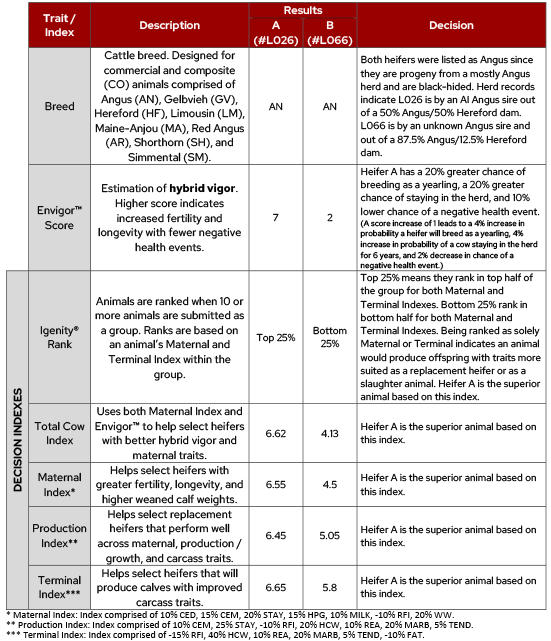
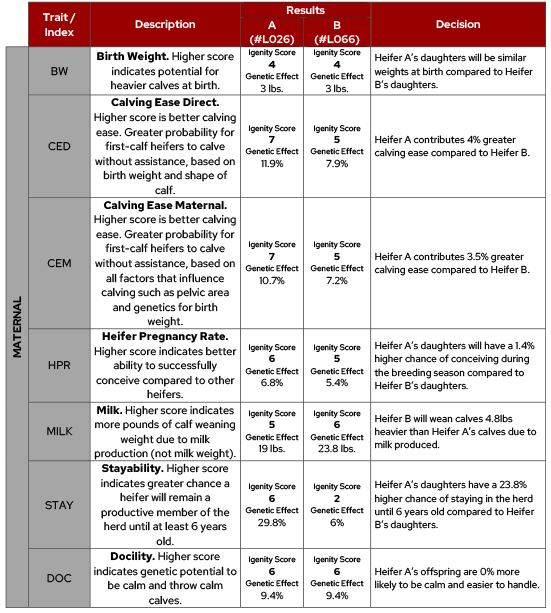
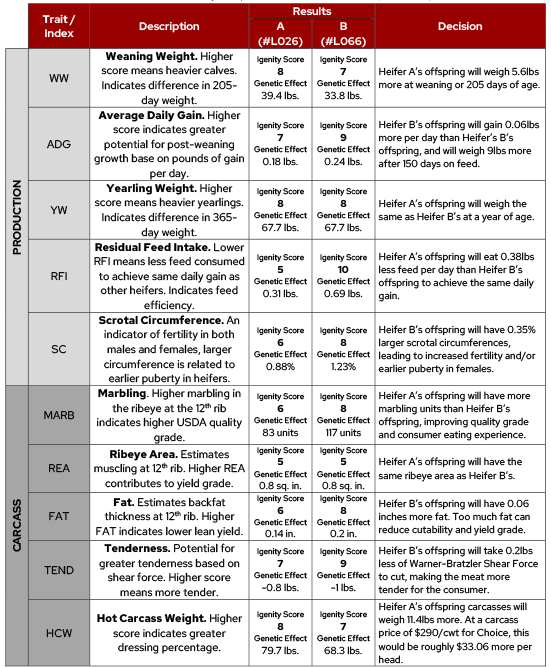
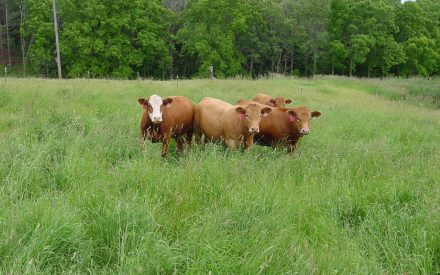 Selecting your Replacement Heifers to Meet Long-term Herd Goals
Selecting your Replacement Heifers to Meet Long-term Herd Goals Raise or purchase replacement heifers?
Raise or purchase replacement heifers?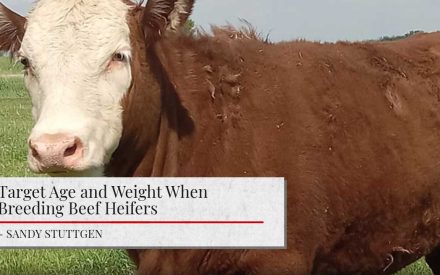 Target Age and Weight When Breeding Beef Heifers
Target Age and Weight When Breeding Beef Heifers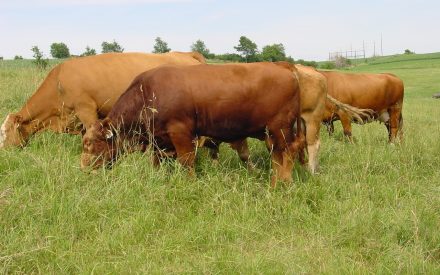 Digging deeper into breeding costs for the beef cow-calf operation
Digging deeper into breeding costs for the beef cow-calf operation


